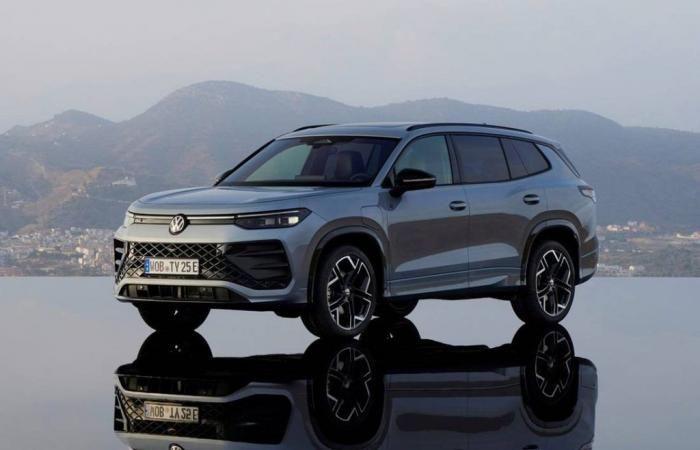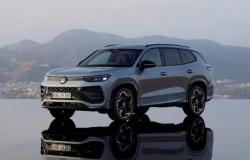The new name should attract more attention
At the beginning of the year, Volkswagen presented the new Tiguan and had delivered more than 40,000 units to Germany by the end of August. And this despite the fact that an important emanation was previously missing in the configurator: the Tiguan Allspace.
VW will only launch the long seven-seater version at the end of 2024, but then under the new name Tayron. Wolfsburg now wants to market its second largest SUV (in Europe), positioned between the Tiguan and the Touareg, as an independent series in order to attract more attention for the model. The longer SUV differs from the Tiguan especially at the front: its hood is significantly higher, which gives the car a somewhat more massive appearance and at the same time better protects pedestrians. As there is more air between the sheet metal and the engine block, the hood does not need to be raised mechanically at lightning speed in the event of an accident, as on the Tiguan. On the other hand, the general height of the vehicle does not change: the Tayron also measures 1.66 meters at the top.
Read now: First test of the VW Tiguan (2024)
The VW Tayron is not only longer, but also visually more massive
The distinctive dual headlights are also slightly taller. With matrix LED technology, you can turn on your LEDs individually for an additional fee and illuminate the street depending on traffic and lighting conditions. The new light signature introduced in the ID.7 in the form of an LED bar with an illuminated VW logo in the middle is also used. On the back, the Tayron also indicates which brand it comes from with a glowing logo. LED technology opens up numerous possibilities for manufacturers to showcase their cars in a sophisticated way. So the Tayron also creates an impressive light show on its red light bank at the rear as soon as the car is opened or closed.
Inside, the SUV is at the same technical and visual level as the Passat, the ID.7 or the Touareg. There are digital instruments, a giant screen, simple operation – even by voice – and many options for customizing light, sound and optics. Depending on equipment, VW liberally uses open-pore wood or backlit applications in the dashboard and door panels.
Access to the third row of seats is difficult
At 4.77 meters, the Tayron is around 23 centimeters longer than the new Tiguan. Half of the increase in length benefits the trunk, the rest goes to the interior, where VW can install two folding seats in the rear on request. But while you sit exceptionally comfortably in the high-back seat and have plenty of legroom, the two third-row seats only accommodate children. You have to be quite agile to climb into the back through the narrow space between the sliding bench seat and the C-pillar.
The backs of all seats can be folded down to create a flat cargo area that rises only slightly at the front. Up to 2,090 liters of storage space is an announcement and even with the backrests raised, several suitcases and bags can be loaded behind the five-seater’s rear bench. Thanks to its tall body, the Tayron could certainly serve as a small van for going to the hardware or furniture store.
Significantly more expensive than the Tiguan
It will be introduced in October at prices starting around 45,000 euros, the Tiguan starts at 38,250 euros. However, the difference with the little brother is put into perspective when you look closer. The large SUV does without basic equipment, works at least in Life level and with a 150 hp TSI petrol engine including DSG. If we compare these versions, the supplement for the long model is reduced to 2,200 euros. The price difference with the Skoda Kodiaq is a little greater: the group’s subsidiary offers its largest SUV from around 42,000 euros. VW also emphasizes that the new Tayron is not a simple copy of the Kodiaq. Although the same basis is used, the car was otherwise developed independently in Wolfsburg and also comes off the production line there. The Skoda, on the other hand, is manufactured in the Czech Republic.
>>>>
But back to the engine range, which is similar to that of the Tiguan. At the high end, people in Lower Saxony are banking on the two new plug-in hybrid variants, which VW also uses in the Passat and Golf. They travel 100 kilometers electrically and can even be recharged at up to 50 kW using a DC fast charger. Part-time electric vehicles are also suitable for customers who really want to drive electric but do not yet have the courage or do not have the necessary charging infrastructure at home. However, due to the battery being located at the rear of the floor, PHEV models are only available as a five-seater. Mileage enthusiasts choose one of the two well-known diesels with 150 or 193 hp. The more powerful TDI is equipped with 4Motion all-wheel drive as standard and is therefore particularly suitable if you want to make the most of the towed load of up to 2.5 tonnes. VW also offers three gasoline engines with up to 265 hp, two of which also feature all-wheel drive technology.
VW uses a new clutch for the 4×4. To save fuel, it disconnects the rear axle when the road is dry. Only when greater grip is required does it transmit the driving forces to the rear wheels via the cardan shaft. When a trailer is attached, the technology activates what is called Trailer Assist. This distributes the drive forces depending on the load and prevents the trailer from starting to swing, for example if the drawbar load is too low. It also helps move the team back in tight spaces.
>>>> The seven-seat VW Atlas is offered in the United States.
Review & first evaluation Tayron/Atlas
In recent months, we have seen a real boom in seven-seater SUVs. Manufacturers such as Hyundai and Kia, Renault, but also Skoda, Peugeot and now Volkswagen are enthusiastically expanding their SUV ranges in order to meet the supposedly growing need for more seats. However, it remains to be seen whether there really is a significant market for these spacious urban SUVs.
Volkswagen has decided to transform the old Tiguan Allspace into the new Tayron – a household name in VW’s portfolio in China since 2018. However, for many customers it is difficult to understand why Volkswagen is extending the Tiguan at great expense instead of just take the roomier VW Atlas from the US to Europe. But the answer seems obvious: a cheaper Atlas could compromise sales of the better-positioned Touareg. (Text: tv, hb/sp-x | Images: manufacturer)






